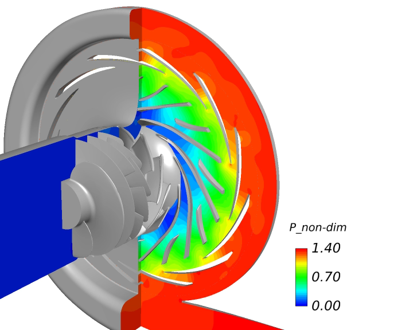Numerical Simulation of Rocket Turbopumps
JAXA Supercomputer System Annual Report April 2018-March 2019
Report Number: R18EG3214
Subject Category: Research and Development
- Responsible Representative: Eiji Shima, Research and Development Directorate, Research Unit III
- Contact Information: Hideyo Negishi(negishi.hideyo@jaxa.jp)
- Members: Takayuki Ito, Hideyo Negishi, Yoichi Ohnishi, Miki Nishimoto, Yu Daimon, Ashvin Hosangadi, Masaaki Ino, Osamu Fukasawa, Shinji Ohno, Andrea Zambon, Takenori Nakajima, Takashi Amemiya, Yutaka Umemura, Hironori Fujiwara, Hiroumi Tani, Keiichiro Fujimoto, Tetsufumi Ohmaru, Akiko Kotani, Taroh Fukuda, Mayu Matsumoto, Masashi Toyama, Daiki Muto, Susumu Teramoto, Takahiko Toki
Abstract
Turbopumps are still one of key components in liquid rocket engine development in terms of cost, time, and risks. Furthermore, a turbopump itself is a complex system consisting of sub-components such as pump, turbine, bearing, balance piston, sealing and so on. From numerical simulation technology point of view, there is no technology able to evaluate performance of an entire turbopump system in the world. And also, accuracy and fidelity of numerical simulation technology for sub-components are still poor and cannot be used to reduce the number of experiments. Therefore, experiments are indispensable to evalute feasibility of considered design in engine development.
In this study, numerical simulation technology of an entire turbopump system applicable in engine design phase has been developed enhancing accuracy and fedelity. We are aiming at reducing cost and time for future engine development by making full use of our numerical simulation to reduce the number of experiments. And also, innovative design methodology for higher performance rocket turbopumps has been investigated by using our numerical simulations.
Reference URL
Please refer to ‘数値シミュレーション技術|第三研究ユニット(旧 情報・計算工学センター)‘.
Reasons for using JSS2
In this study, JSS2 has been used because of the following reasons:
(1) To make it possible to perform large-scale numerical simulations with high accuracy and fidelity
(2) To produce a lot of computed results on time within limited short period of time under JAXA’s rocket development
(3) To ensure information security about rocket-related technical information in JAXA’s network only
Achievements of the Year
In fiscal year 2018, we succeded in performing three-dimensional compressible URANS simulation of liquid rocket hydrogen pump considering cryogenic physical properties based on NIST database (See Fig. 1). It was confirmed that computed pressures in the pump agreed well with experimental results within 4% error. The developed numerical simulation approach has been employed in the booster engine LE-9 development of H3 launch vehicle.
Publications
– Peer-reviewed papers
(1) Negishi, H., et al., “Investigation on Flow Field Characteristics of a Liquid Rocket Open Impeller Based on Compressible URANS Simulation”, Vol. 46, No. 12, Dec. 2018, pp. 705-714.
– Non peer-reviewed papers
(1) Negishi, H., et al., “Computational analysis of flow field characteristics of a liquid rocket unshrouded impeller,” 29th IAHR Symposium on Hydraulic Machinery and Systems, IAHR2018-422, Kyoto, Sep. 16-21, 2018.
(2) Negishi, H., et al., “Thermal-flow Field Characteristics of a Liquid Hydrogen Open Impeller (Influence of Flow Coefficient),” 80th Turbomachinery Society of Japan, Academic conference, Oct. 2018.
Usage of JSS2
Computational Information
- Process Parallelization Methods: MPI
- Thread Parallelization Methods: FLAT
- Number of Processes: 128 – 6400
- Elapsed Time per Case: 300 Hour(s)
Resources Used
Fraction of Usage in Total Resources*1(%): 0.42
Details
Please refer to System Configuration of JSS2 for the system configuration and major specifications of JSS2.
| System Name | Amount of Core Time(core x hours) | Fraction of Usage*2(%) |
|---|---|---|
| SORA-MA | 3,576,887.13 | 0.44 |
| SORA-PP | 7,545.15 | 0.06 |
| SORA-LM | 1,114.21 | 0.52 |
| SORA-TPP | 19.56 | 0.00 |
| File System Name | Storage Assigned(GiB) | Fraction of Usage*2(%) |
|---|---|---|
| /home | 495.16 | 0.51 |
| /data | 31,784.03 | 0.56 |
| /ltmp | 16,295.88 | 1.40 |
| Archiver Name | Storage Used(TiB) | Fraction of Usage*2(%) |
|---|---|---|
| J-SPACE | 2.61 | 0.09 |
*1: Fraction of Usage in Total Resources: Weighted average of three resource types (Computing, File System, and Archiver).
*2: Fraction of Usage:Percentage of usage relative to each resource used in one year.
JAXA Supercomputer System Annual Report April 2018-March 2019



